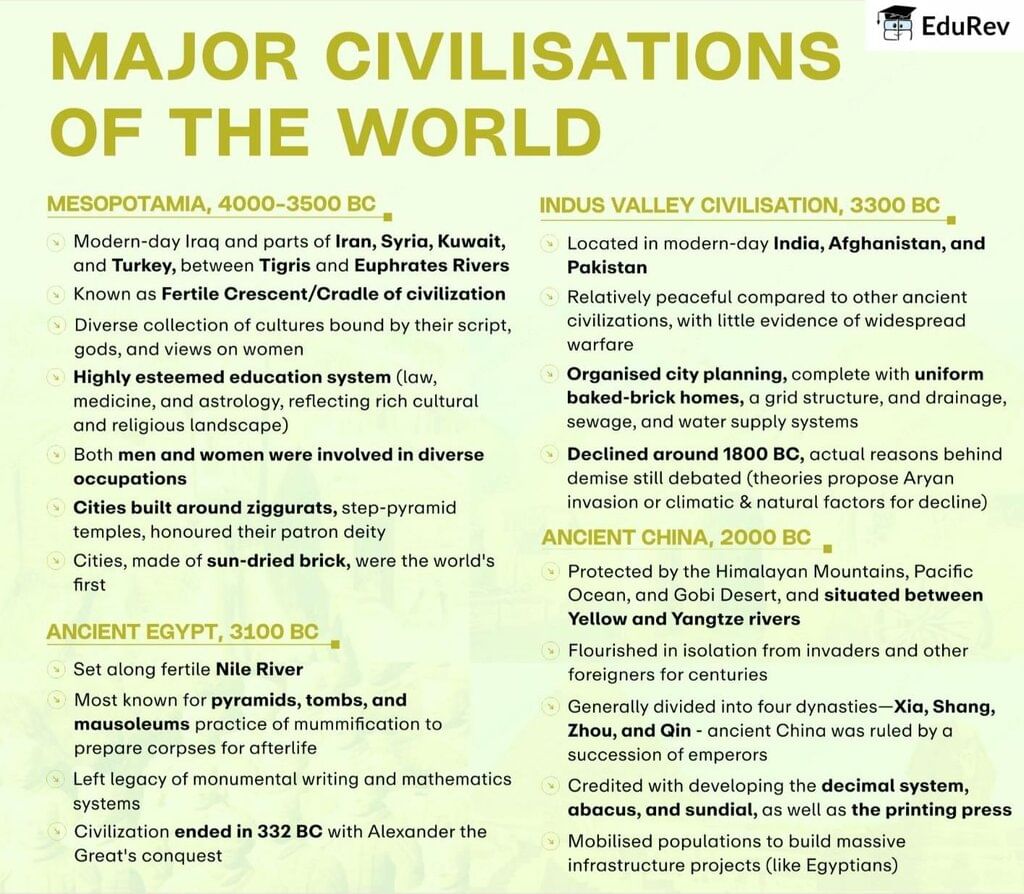UPSC Exam > UPSC Notes > History for UPSC CSE > Infographic: Major Civilisations of the World
Infographic: Major Civilisations of the World | History for UPSC CSE PDF Download

The document Infographic: Major Civilisations of the World | History for UPSC CSE is a part of the UPSC Course History for UPSC CSE.
All you need of UPSC at this link: UPSC
|
216 videos|855 docs|219 tests
|
FAQs on Infographic: Major Civilisations of the World - History for UPSC CSE
| 1. What are the key characteristics that define a major civilization? |  |
Ans. Major civilizations are typically characterized by several key features: a stable food supply, social structure, government, religion, culture, and advancements in technology and writing. They often have organized cities and a complex economy that supports trade and commerce. Furthermore, civilizations tend to have significant contributions to art, architecture, and intellectual achievements that influence subsequent societies.
| 2. What are some examples of ancient major civilizations and their contributions to modern society? |  |
Ans. Some prominent examples of ancient major civilizations include Mesopotamia, Egypt, the Indus Valley, China, and the Mesoamerican cultures. Mesopotamia is known for the invention of writing (cuneiform) and the wheel. Ancient Egypt contributed monumental architecture like the pyramids and advancements in medicine. The Indus Valley civilization is notable for urban planning and drainage systems. Ancient China is recognized for innovations such as papermaking and gunpowder, while Mesoamerican cultures like the Maya and Aztec contributed to astronomy and mathematics.
| 3. How do historians classify civilizations, and what criteria do they use? |  |
Ans. Historians classify civilizations based on various criteria, including geographic location, cultural practices, political structures, and technological advancements. They often assess the level of urbanization, social hierarchy, economic systems, religious beliefs, and written records. This classification helps to understand the development, interactions, and influences of different civilizations throughout history.
| 4. What role did trade play in the development of major civilizations? |  |
Ans. Trade played a crucial role in the development of major civilizations by facilitating the exchange of goods, ideas, and cultural practices. It helped to establish economic ties between different regions, leading to increased wealth and the emergence of social classes. Trade routes, such as the Silk Road, enabled the spread of technology, religion, and art, significantly contributing to the growth and interconnectedness of civilizations.
| 5. How did major civilizations influence each other throughout history? |  |
Ans. Major civilizations influenced each other through cultural exchange, trade, warfare, and diplomacy. For instance, the spread of Greek culture during the Hellenistic period influenced the Roman Empire, while the interactions between the Islamic Caliphates and European kingdoms led to the transmission of knowledge in science, medicine, and philosophy. Such interactions often resulted in the blending of ideas and practices, shaping the development of societies across different regions.
Related Searches





















